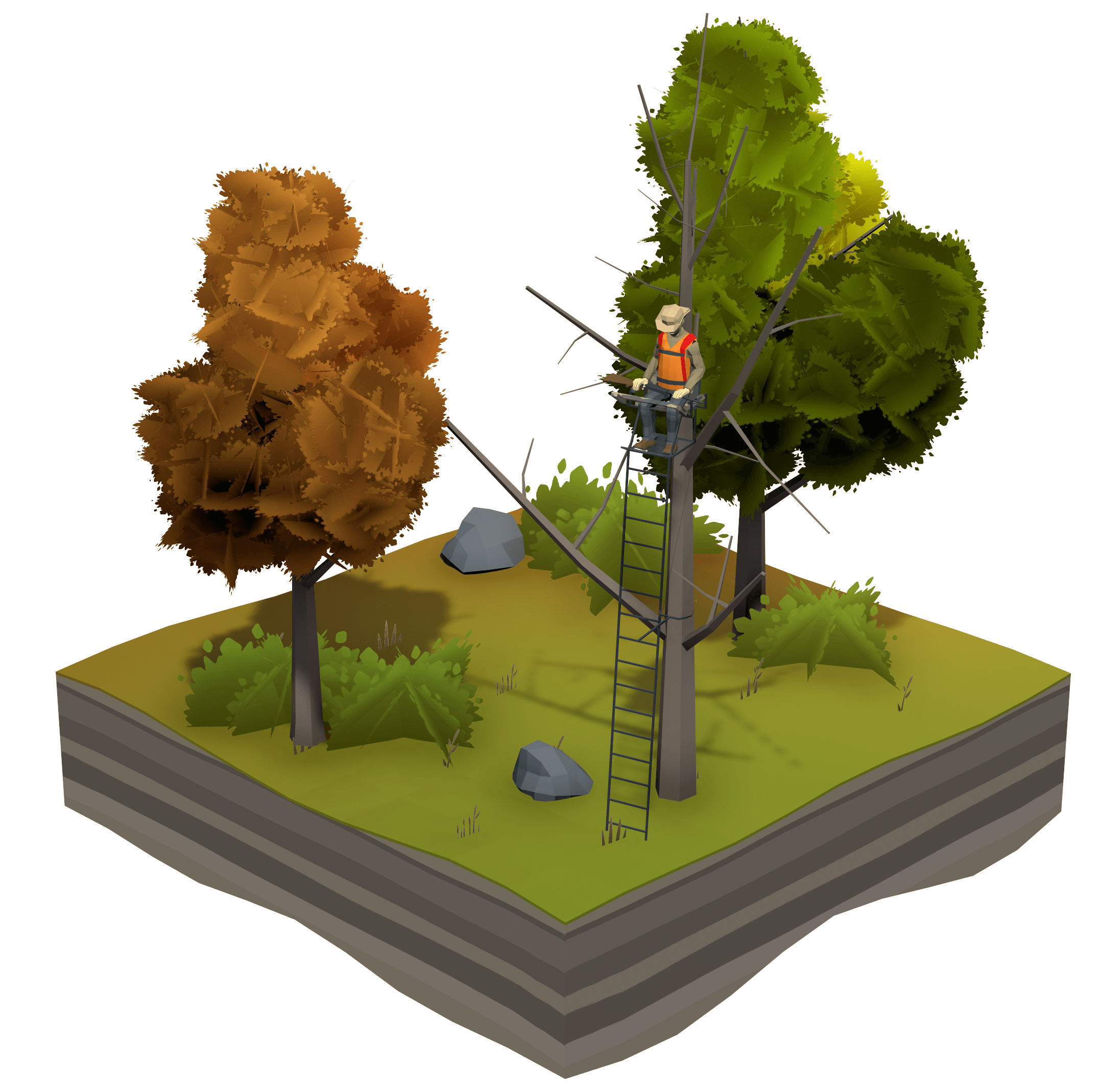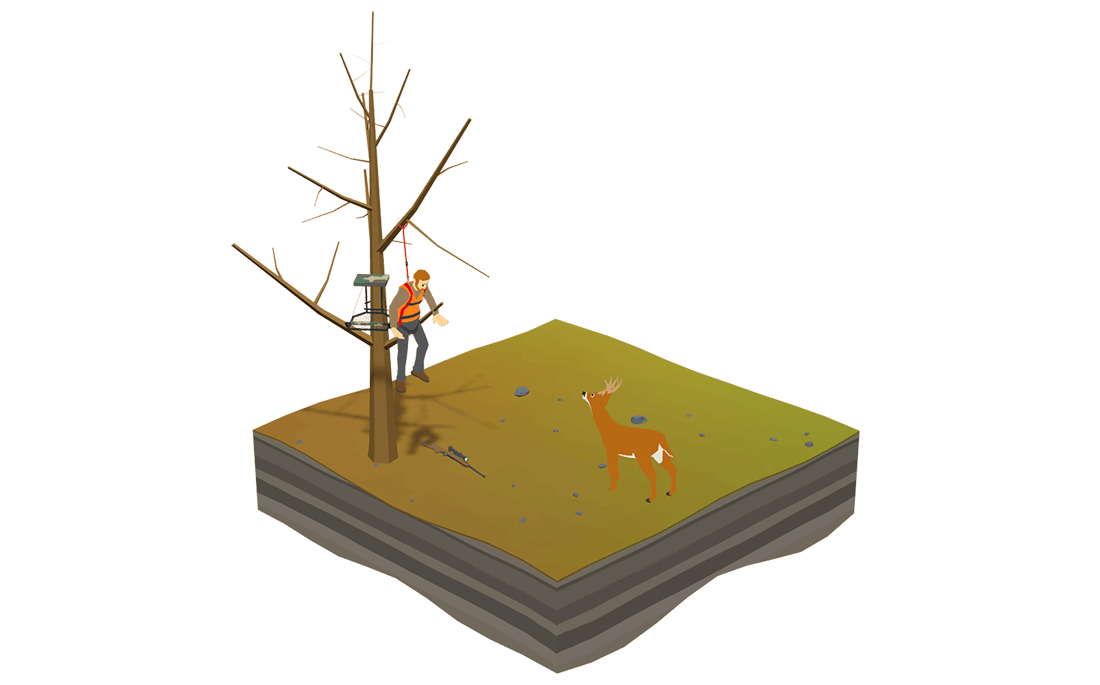Elevated Stand Safety Tips Introduction

-
Securely attach the elevated stand to the tree.
-
Unload your firearm before climbing into the elevated stand.
-
All firearms should be raised or lowered while unloaded, safety on, action open, and muzzle pointing downward.
-
Never climb the elevated stand with a weapon. Once at the top of the elevated stand, you can raise your weapon and equipment using a rope.
-
Use a FBH/FAS to attach yourself to the tree
-
A FBH/FAS should be properly worn and attached to the tree from the moment you climb your stand until you safely return to the ground. Inspect thoroughly the elevated stand, all safety devices, and the FBH/FAS before each use and do not store an elevated stand outdoors when not in use.
-
Suspension trauma can occur if you hang too long in a FBH/FAS. Suspension trauma relief devices are now sold and should be a part of your personal rescue plan.
-
Follow the manufacturer’s instructions.
-
Practice at ground level before climbing.
-
Never modify your stand in any way by making repairs, replacing parts, altering the design or by adding or attaching anything to it except if explicitly authorized in writing by the manufacturer.
-
Use three points of contact when climbing.
-
Use a haul line to pull up firearms, bows or other equipment.
-
Never use an elevated stand while under the influence of mood-altering drugs (including prescription drugs) or alcohol, when feeling ill, nauseous or dizzy, or if you have a prior medical condition that could cause a problem.
-
Never jump or bounce on an elevated stand to seat it to the tree.
-
Never exceed the weight limit of an elevated stand as specified by the manufacturer.
-
Always know your physical limitations and avoid excessive heights. Remember, the laws of physics take over when you fall; you fall at a constantly increasing rate of speed as the distance increases.
-
The further you fall, the more it will hurt when you hit the ground. Never hurry! Take your time and be safe.
-
Never use an elevated stand during inclement weather such as rain, lightning, windstorms or icy conditions. End your hunt and return to the ground if inclement conditions arise.
-
Having a safe, successful hunt includes prior scouting before the hunting season to select appropriate trees for your stand sites. Never select a dead, leaning, diseased, or loose-barked tree or utility pole for a stand site. Always use a tree that is straight and healthy.
-
If someone has fallen from an elevated stand and a neck or back injury is suspected, keep the victim still and get medical help before moving them.
Falling from an Elevated Stand

Injuries related to elevated stand use could be significantly reduced by properly using a Full Body Harness / Fall Arrest System (FBH/FAS). You will only fall a few inches if you are properly using one.

Self-extraction or recovery after falling from an elevated stand is a critical component of elevated stand safety. Safely returning to the ground or elevated stand can be accomplished in a variety of ways.
Recover and get back on the platform as quickly as possible. Hunters with varying degrees of physical fitness may require different plans to safely descend to the ground or escape the effects of suspension trauma.
Suspension trauma – blood pooling in the legs – occurs when an individual falls and hangs from a FBH/FAS for an extended period of time. Relieve pressure on your legs by using your suspension relief device by stepping into the loop and standing up to relieve pressure caused by the leg straps. If you do not have a suspension relief strap, keep moving your legs by pushing against the tree until help arrives. Failure to return to your stand or minimize the effects of suspension trauma could result in serious injury or death. Suspension trauma relief devices are now sold with each FBH/FAS or elevated stand. Follow the manufacturer's recommendations regarding their use.
Stay calm and call for help. You should always be prepared to be rescued if self-extraction or recovery from a fall is not possible. Signal for help. You should always carry an emergency signal device, such as a radio, cell phone, whistle, signal flare on your person and within reach at all times in case of emergency. Always let others know your exact hunting location, where your elevated stand is located, when you plan to return and who is with you before you go.
Develop a personal self-rescue or recovery plan prior to leaving the ground. Each individual should know their limitations and stay within their means to enjoy a safe hunt and return home.
There is time to make correct decisions on a course of action if a fall occurs while wearing a FBH/FAS . But it is essential that elevated stand accident victims remain calm and implement their practiced rescue, relief, and recovery plan.
Hunting Transmission Line Rights of Way
You must have permission from the landowner to hunt the transmission line rights of way.
Acceptable Stand Locations:
- Stands must be placed on the outer 5 feet from the Rights of Way; and
- Stands must be a minimum of 25 feet from transmission line infrastructure (poles, towers, guys, anchors); and
- Stands must not block access to the Rights of Way
Prohibited Stand Locations:
Do NOT- attach anything to a transmission tower or power poles
- Do NOT block access or locate close to facilities
- Do NOT put structures underneath high-voltage lines
Any violation of the above will result in the immediate removal or relocation of your stand.
It is UNLAWFUL and RECKLESS to shoot electrical poles, towers, conductors, insulators, guys, anchors, transformers, and/or other electrical facilities. Violators could be prosecuted to the full extent of the law.